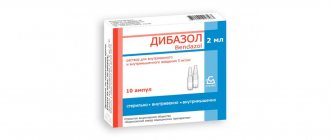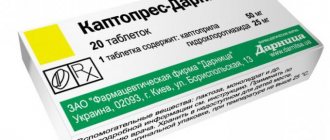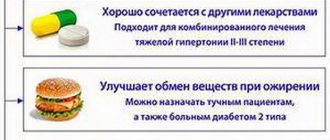Compound
| Pills | 1 table |
| composition based on 1 table. listed in the table |
| Active ingredients | Tablet dosage, mg | ||
| 0,625 + 2 | 1,25 + 4 | 2,5 + 8 | |
| Indapamide | 0,625 | 1,25 | 2,5 |
| perindopril erbumine K semi-finished granules | 37,515 | 75.030 mg | 150,06 |
| Active substance of the semi-finished granule product | |||
| Perindopril erbumine | 2 | 4 | 8 |
| Excipients for semi-finished granules | |||
| calcium chloride hexahydrate | 0,6 | 1,2 | 2,4 |
| lactose monohydrate | 30,915 | 61,83 | 123,66 |
| crospovidone | 4 | 8 | 16 |
| Excipients | |||
| MCC | 11,25 | 22,5 | 45 |
| sodium bicarbonate | 0,25 | 0,5 | 1 |
| colloidal silicon dioxide | 0,135 | 0,27 | 0,54 |
| magnesium stearate | 0,225 | 0,45 | 0,9 |
Information about the product
Release form
The blood pressure medication Perineva is available in the form of white tablets with different contents of the main component. Round tablets contain 2 and 8 mg of perindopril, and oval tablets contain 4 mg of the substance.
Each tablet is packaged in an individual blister cell. One blister contains 10 tablets. A pack can contain 30 or 90 tablets. The kit includes instructions for using Perineva.
Composition of tablets
The main active ingredient of the tablets is Perindopril erbumine.
Additional components:
- calcium chloride hexahydrate;
- polyvinylpyrrolidone;
- lactose monohydrate;
- silica;
- magnesium stearate;
- cellulose.
Packaging of Perinev tablets
Price and terms of sale
The drug Perineva is sold in pharmacies with a prescription. The cost of Perinev's blood pressure tablets is 210 rubles for a package of 30 tablets and 1000 rubles for a package of 90 tablets. The price of Perineva depends on the amount of the main substance included in the composition.
Storage conditions
The drug for Perinev's blood pressure should be stored in a place protected from children at room temperature.
The shelf life of the medicine is 3 years from the date of manufacture. After the expiration date, tablets must be disposed of in accordance with sanitary standards.
Pharmacodynamics
Co-Perineva® is a combination drug containing an ACE inhibitor - perindopril and a thiazide-like diuretic - indapamide. The drug has antihypertensive, diuretic and vasodilating effects.
Co-Perineva® has a pronounced dose-dependent antihypertensive effect, independent of the patient’s age and body position and not accompanied by reflex tachycardia. Does not affect lipid metabolism (total cholesterol, LDL, VLDL, HDL, triglycerides (TG) and carbohydrates), incl. in patients with diabetes mellitus. Reduces the risk of hypokalemia caused by diuretic monotherapy.
The antihypertensive effect lasts for 24 hours.
A stable reduction in blood pressure is achieved within 1 month with the use of the drug Co-Perineva® without an increase in heart rate. Stopping treatment does not lead to the development of withdrawal syndrome.
Perindopril is an ACE inhibitor, the mechanism of action of which is associated with inhibition of ACE activity, leading to a decrease in the formation of angiotensin II, eliminates the vasoconstrictor effect of angiotensin II, reduces the secretion of aldosterone. The use of perindopril does not lead to sodium and fluid retention and does not cause reflex tachycardia during long-term treatment. The antihypertensive effect of perindopril develops in patients with low or normal plasma renin activity.
Perindopril acts through its main active metabolite, perindoprilate. Its other metabolites are inactive. The effect of the drug Co-Perineva® leads to:
- dilation of veins (reduction of preload on the heart), caused by changes in PG metabolism;
- reduction of peripheral vascular resistance (reduction of afterload on the heart).
In patients with heart failure, perindopril helps:
- decreased filling pressure of the left and right ventricles;
- increase in cardiac output and cardiac index;
- increasing regional blood flow in the muscles.
Perindopril is effective for arterial hypertension of any severity: mild, moderate and severe. The maximum antihypertensive effect develops 4–6 hours after a single oral dose and persists throughout the day. Discontinuation of therapy does not lead to the development of withdrawal syndrome.
It has vasodilating properties and restores the elasticity of large arteries. The addition of a thiazide-like diuretic enhances (addition) the antihypertensive effect of perindopril.
Indapamide is a sulfonamide derivative and is a diuretic. Inhibits the reabsorption of sodium in the cortical segment of the renal tubules, increasing the excretion of sodium and chlorine by the kidneys, thus leading to increased diuresis. To a lesser extent increases the excretion of potassium and magnesium. Having the ability to selectively block “slow” calcium channels, indapamide increases the elasticity of arterial walls and reduces peripheral vascular resistance. It has a hypotensive effect in doses that do not have a pronounced diuretic effect. Increasing the dose of indapamide does not increase the antihypertensive effect, but increases the risk of adverse events.
Indapamide in patients with arterial hypertension has no effect on lipid metabolism: TG, LDL and HDL and carbohydrate metabolism, even in patients with diabetes mellitus and arterial hypertension.
Pharmacokinetics
The combined use of perindopril and indapamide does not change their pharmacokinetic parameters compared to the separate administration of these drugs.
Perindopril after oral administration is rapidly absorbed from the gastrointestinal tract. Bioavailability is 65–70%. Eating reduces the conversion of perindopril to perindoprilat. T1/2 of perindopril from blood plasma is 1 hour.
Cmax in blood plasma is achieved 3–4 hours after oral administration. Since taking with food reduces the conversion of perindopril to perindoprilat and the bioavailability of the drug, perindopril should be taken once a day in the morning, before breakfast. Taking perindopril once a day, equilibrium concentration is achieved within 4 days.
It is metabolized in the liver to form an active metabolite - perindoprilate. In addition to the active metabolite perindoprilate, perindopril forms 5 more inactive metabolites. The binding of perindoprilate to plasma proteins is dose-dependent and amounts to 20%. Perindoprilat easily passes through histohematic barriers, excluding the blood-brain barrier; a small amount penetrates the placenta and into breast milk. Excreted by the kidneys, T1/2 of perindoprilate is about 17 hours. It does not accumulate.
In elderly patients and in patients with renal and heart failure, the elimination of perindoprilate is slowed down.
In case of renal failure, it is recommended to reduce the dose of perindopril depending on the severity of renal failure (creatinine clearance). The dialysis Cl of perindoprilate is 70 ml/min.
The kinetics of perindopril is altered in patients with liver cirrhosis: hepatic clearance is reduced by half. However, the amount of perindoprilate formed does not decrease, which does not require dose adjustment.
Indapamide. Quickly and almost completely absorbed into the gastrointestinal tract. Eating slightly slows down absorption, but does not significantly affect the amount of indapamide absorbed. Cmax in blood plasma is achieved 1 hour after oral administration of a single dose. Binds to plasma proteins by 79%. T1/2 ranges from 14 to 24 hours (average 18 hours). Does not accumulate.
Metabolized in the liver. It is excreted by the kidneys (70%) mainly in the form of metabolites (the fraction of the unchanged drug is about 5%) and by the intestines with bile in the form of inactive metabolites (22%). In patients with renal failure, the pharmacokinetic parameters of indapamide do not change significantly.
Contraindications
hypersensitivity to the active substance, any ACE inhibitor, sulfonamide derivatives or any excipients of the drug;
angioedema (hereditary, idiopathic or angioedema) while taking other ACE inhibitors (history);
severe renal failure (creatinine Cl less than 30 ml/min);
bilateral renal artery stenosis, stenosis of the artery of a single kidney;
refractory hyperkalemia;
lactose intolerance, lactase deficiency or glucose-galactose malabsorption;
simultaneous use of drugs that prolong the QT interval on the ECG, simultaneous use with antiarrhythmic drugs that can cause ventricular tachycardia of the “pirouette” type (see “Interaction”);
severe liver failure (including encephalopathy);
pregnancy, breastfeeding, age under 18 years (efficacy and safety have not been established);
Given the lack of sufficient experience with use, Co-Perineva® should not be taken by patients on dialysis and patients with untreated decompensated heart failure.
With caution: systemic connective tissue diseases (including systemic lupus erythematosus (SLE), scleroderma), therapy with immunosuppressants (risk of developing neutropenia, agranulocytosis), inhibition of bone marrow hematopoiesis, decreased blood volume (taking diuretics, salt-free diet, vomiting, diarrhea) , angina pectoris, cerebrovascular diseases, renovascular hypertension, diabetes mellitus, chronic heart failure (functional class IV according to the NYHA classification), hyperuricemia (especially accompanied by gout and urate nephrolithiasis), blood pressure lability, elderly patients, hemodialysis using high-flow polyacrylonitrile membranes; before the LDL apheresis procedure, simultaneous desensitizing therapy with allergens (for example, hymenoptera venom); condition after kidney transplantation, stenosis of the aortic and/or mitral valve, hypertrophic obstructive cardiomyopathy.
For whom is it contraindicated?
Perineva for blood pressure has absolute and relative contraindications.
Absolute contraindications include:
- galactosemia;
- hypolactasia;
- glucose-galactose malabsorption;
- individual intolerance to components;
- Quincke's edema.
The medication is contraindicated in children under 18 years of age.
Children's age is a contraindication to taking the drug
Use during pregnancy and breastfeeding
Pregnancy. Taking Co-Perineva® is contraindicated during pregnancy. If you are planning pregnancy or if it occurs while taking Co-Perineva®, you should immediately stop taking the drug and prescribe other antihypertensive therapy. You should not use Co-Perineva® in the first trimester of pregnancy. There have been no controlled clinical studies on the use of ACE inhibitors in pregnant women. Limited data indicate that taking ACE inhibitors in the first trimester did not lead to fetotoxicity-related fetal malformations, but the fetotoxic effect of ACE inhibitors cannot be completely excluded. The drug Co-Perineva® is contraindicated in the second and third trimesters of pregnancy. Long-term use of ACE inhibitors in the second and third trimesters of pregnancy can lead to impaired fetal development (decreased renal function, oligohydramnios, delayed ossification of the skull bones) and the development of complications in the newborn (renal failure, arterial hypotension, hyperkalemia).
Long-term use of thiazide diuretics in the third trimester of pregnancy can cause hypovolemia in the mother and a decrease in uteroplacental blood flow, which leads to fetoplacental ischemia and fetal growth retardation. In rare cases, while taking diuretics, hypoglycemia and thrombocytopenia may develop in the fetus/newborn. If a woman took an ACE inhibitor in the second and third trimesters of pregnancy, it is recommended to conduct an ultrasound of the kidneys and skull of the fetus/newborn.
In newborns whose mothers received therapy with ACE inhibitors, hypotension may occur, so newborns should be under close medical supervision.
Breastfeeding period. The drug Co-Perineva® is contraindicated during breastfeeding.
It is not known whether perindopril is excreted in breast milk.
Indapamide is excreted in breast milk. Causes a decrease or suppression of lactation. The newborn may develop hypersensitivity to sulfonamide derivatives, hypokalemia and nuclear jaundice.
It is necessary to assess the significance of therapy for the mother and make a decision to stop breastfeeding or stop taking the drug.
Is it possible to drive a car
Taking Perineva medication with high blood pressure can lead to a deterioration in psychomotor reactions, so it is necessary to refrain from driving vehicles during the course of treatment. The patient should refrain from performing work that requires increased concentration or complex mental processes. You cannot work with complex systems and mechanisms.
Taking the drug affects memory, concentration, causes headaches, vestibular disorders, confusion, which can lead to an accident on the road.
If adverse reactions occur in the body, you should consult a doctor who will adjust the dosage or select another method of therapeutic intervention.
Taking Perineva may affect the quality of work that requires concentration
Side effects
Perindopril has an inhibitory effect on the RAAS and reduces the excretion of potassium ions by the kidneys while taking indapamide. The risk of developing hypokalemia (serum potassium content less than 3.4 mmol/l) in patients using the drug Co-Perineva® at a daily dose of 0.625 mg/2 mg is 2%, 1.25 mg/4 mg - 4% and 2.5 mg/8 mg - 6%.
WHO classification of the incidence of side effects: very often - ≥1/10; often - from ≥1/100 to <1/10; uncommon - from ≥1/1000 to <1/100; rarely - from ≥1/10000 to <1/1000; very rare - from <1/10000, frequency unknown - cannot be estimated based on available data. Within each group, adverse effects are presented in order of decreasing severity.
From the hematopoietic organs: very rarely - thrombocytopenia, leukopenia/neutropenia, agranulocytosis, aplastic anemia, hemolytic anemia (there are reports with the use of ACE inhibitors). In certain clinical situations (conditions after kidney transplantation or in patients on hemodialysis or peritoneal dialysis), ACE inhibitors may cause anemia.
From the central and peripheral nervous system: often - paresthesia, headache, dizziness, vertigo; infrequently - mood lability, sleep disturbances; very rarely - confusion.
From the senses: often - visual impairment, tinnitus.
From the cardiovascular system: often - a pronounced decrease in blood pressure, incl. orthostatic hypotension; very rarely - arrhythmias, incl. and bradycardia, ventricular tachycardia, atrial fibrillation, as well as angina pectoris, myocardial infarction, possibly secondary, due to a decrease in blood pressure in high-risk patients; frequency unknown - ventricular tachycardia of the “pirouette” type (possibly fatal).
From the respiratory system: often - a dry cough that persists for a long time during the use of ACE inhibitors and disappears after their cessation; dyspnea; uncommon - bronchospasm; very rarely - eosinophilic pneumonia, rhinitis.
From the digestive system: often - constipation, dryness of the oral mucosa, loss of appetite, nausea, epigastric pain, abdominal pain, impaired taste perception, vomiting, dyspepsia, diarrhea; very rarely - pancreatitis, angioedema of the intestine, jaundice; frequency has not been established - in case of liver failure, there is a possibility of developing hepatic encephalopathy.
From the skin and subcutaneous fat: often - itching, skin rash, maculopapular rash; uncommon - angioedema of the face, extremities, lips, oral mucosa, tongue, vocal folds and/or larynx, urticaria; hypersensitivity reactions, mainly dermatological, in patients with a history of allergic reactions; worsening of SLE; very rarely - erythema multiforme, toxic epidermal necrolysis, Stevens-Johnson syndrome; isolated cases of photosensitivity reaction.
From the musculoskeletal system: often - muscle spasms.
From the urinary system: infrequently - renal failure; very rarely - acute renal failure.
From the reproductive system: infrequently - impotence.
Other: often - asthenia; infrequently - increased sweating.
Laboratory indicators: rarely - hypercalcemia; frequency unknown - increase in QT on the ECG; increased concentrations of uric acid and glucose in the blood serum while taking the drug; increased activity of liver enzymes; a slight increase in plasma creatinine concentration, reversible after cessation of therapy, which often develops against the background of renal artery stenosis or stenosis of the artery of a single kidney, arterial hypertension during diuretic therapy, and renal failure; hypokalemia, especially significant for patients at risk; hypochloremia can lead to compensatory metabolic alkalosis (the likelihood and severity of the effect is low); hyperkalemia is often reversible; hyponatremia with hypovolemia, leading to a decrease in blood volume and orthostatic hypotension.
According to clinical studies, side effects correspond to the previously established safety profile of the combination of perindopril and indapamide. In rare cases, the following serious adverse events have developed: hyperkalemia, acute renal failure, arterial hypotension and cough, and the possible development of angioedema.
Interaction
Concomitant use is not recommended
Lithium preparations. With the simultaneous use of lithium preparations and ACE inhibitors, cases of reversible increases in the concentration of lithium in the blood serum have been reported. Concomitant use of thiazide diuretics may increase the concentration of lithium in the blood plasma and the risk of its toxic effect while taking an ACE inhibitor.
The simultaneous use of Co-Perineva® with lithium preparations is not recommended. If concurrent use is necessary, serum lithium concentrations should be carefully monitored.
Concomitant use requiring special caution
Baclofen - potentiation of the hypotensive effect. It is necessary to monitor blood pressure, renal function and, if necessary, adjust the dose of antihypertensive drugs.
NSAIDs, incl. high doses of acetylsalicylic acid (more than 3 g/day). The simultaneous use of ACE inhibitors with NSAIDs (including acetylsalicylic acid in doses that have an anti-inflammatory effect, COX-2 inhibitors and non-selective NSAIDs) reduces the hypotensive effect of ACE inhibitors, increases the risk of developing renal dysfunction, including the development of acute renal failure, increases serum potassium levels blood, especially in patients with pre-existing renal impairment.
This combination is recommended to be used with caution, especially in elderly patients. Before starting treatment, patients need to compensate for fluid loss, as well as regularly monitor kidney function both at the beginning of therapy and during treatment.
Concomitant use requiring caution
Tricyclic antidepressants, antipsychotics (neuroleptics). They enhance the hypotensive effect and increase the risk of developing orthostatic hypotension (additive effect).
GCS, tetracosactide. Reducing the hypotensive effect (retention of fluid and sodium ions as a result of the action of corticosteroids).
Other antihypertensive drugs: the hypotensive effect of Co-Perineva® may be enhanced.
Perindopril
Concomitant use is not recommended
Potassium-sparing diuretics (spironolactone, triamterene, amiloride, eplerenone) and potassium supplements: ACE inhibitors reduce diuretic-induced renal potassium loss. When used together with ACE inhibitors, it is possible to increase the potassium content in the blood serum, including death. If simultaneous use of an ACE inhibitor and the above drugs is necessary (in case of confirmed hypokalemia), caution should be exercised and regular monitoring of potassium levels in the blood plasma and ECG parameters should be carried out.
Concomitant use requiring special caution
Oral hypoglycemic agents (sulfonylureas) and insulin: the use of ACE inhibitors (described for captopril and enalapril) in very rare cases may enhance the hypoglycemic effect of sulfonylureas and insulin in patients with diabetes mellitus; with their simultaneous use, it is possible to increase glucose tolerance and reduce the need for insulin, which may require dose adjustment of oral hypoglycemic agents and insulin.
Concomitant use requiring caution
Allopurinol, cytostatic immunosuppressants, corticosteroids (for systemic use) and procainamide: simultaneous use of these drugs with ACE inhibitors may increase the risk of developing leukopenia.
General anesthetics: ACE inhibitors may enhance the hypotensive effect of some general anesthetics.
Diuretics (thiazide and loop): the use of diuretics in high doses can lead to hypovolemia (due to a decrease in blood volume), and the addition of perindopril to therapy can lead to a pronounced decrease in blood pressure.
Indapamide
Concomitant use requiring special caution
Drugs that cause ari: because there is a risk of developing hypokalemia, indapamide should be used with caution simultaneously with drugs that can cause ventricular tachycardia of the “pirouette” type, such as: antiarrhythmic drugs (quinidine, hydroquinidine, disopyramide, amiodarone, dofetilide, ibutilide, bretylium tosylate, sotalol); some antipsychotics (chlorpromazine, cyamemazine, levomepromazine, thioridazine, trifluoperazine), benzamides (amisulpride, sulpiride, sultopride, tiapride), butyrophenones (droperidol, haloperidol), other antipsychotics (pimozide); other drugs, such as bepridil, cisapride, difemanil methyl sulfate, erythromycin for IV use, halofantrine, mizolastine, moxifloxacin, pentamidine, sparfloxacin, vincamine for IV use, methadone, astemizole, terfenadine. Concomitant use with the above drugs should be avoided. It is necessary to monitor the potassium content in the blood serum to avoid hypokalemia, the development of which requires its correction, and to monitor the QT interval on the ECG.
Medicines that can cause hypokalemia: amphotericin B when administered intravenously, gluco- and mineralocorticoids (when administered systemically), laxatives that stimulate intestinal motility (laxatives that do not stimulate intestinal motility should be used), tetracosactide - increases the risk of hypokalemia ( additive effect). It is necessary to monitor the potassium content in the blood plasma and, if necessary, correct it. Particular attention should be paid to patients concomitantly receiving cardiac glycosides.
Cardiac glycosides: hypokalemia enhances the toxic effect of cardiac glycosides. With the simultaneous use of indapamide and cardiac glycosides, the potassium content in the blood plasma, ECG readings should be monitored and, if necessary, the dose of cardiac glycosides should be adjusted.
Concomitant use requiring caution
Metformin: functional renal failure while taking diuretics, especially loop diuretics, when used simultaneously with metformin increases the risk of developing lactic acidosis. Metformin should not be used if the plasma creatinine concentration exceeds 15 mg/l (135 µmol/l) in men and 12 mg/l (110 µmol/l) in women.
Iodinated contrast media: Patients with hypovolemia while receiving diuretics have an increased risk of developing acute renal failure, especially when using contrast media containing high doses of iodine. Before using iodine-containing contrast agents, the blood volume should be replenished.
Preparations containing calcium salts: with simultaneous use, hypercalcemia may develop due to a decrease in calcium excretion by the kidneys.
Cyclosporine: it is possible to increase the concentration of creatinine in the blood plasma without changing the concentration of cyclosporine in the blood plasma, even in the absence of pronounced loss of sodium ions and dehydration.
Special instructions and recommendations
When taking Perineva for high blood pressure, you must follow the schedule. You need to take the pills at the same time. Do not break, crush, dissolve or chew the tablets. They are taken whole with a sufficient amount of drinking water.
If you miss one, you do not need to take two tablets at once, as this may cause an overdose.
Other recommendations:
- Transient hypertension will not be an indication to interrupt treatment. Taking the pills is stopped until the condition normalizes, and then therapy is continued according to the proposed regimen.
- The doctor adjusts the dosage if adverse reactions occur.
- The doctor evaluates the benefits and harms of the drug in patients with ischemia and the development of angina.
- If Quincke's edema occurs, stop taking Perinev tablets and call an ambulance.
- If jaundice occurs, stop taking the tablets. The patient is sent to a medical facility to undergo a comprehensive examination to identify pathologies in the liver.
- Taking Perinev blood pressure tablets can cause a temporary increase in blood creatinine and urea levels.
- Patients with diabetes who are taking antidiabetic agents or insulin need to monitor their blood glucose levels.
- The day before the upcoming operation, you must stop taking Perinev tablets, since anesthesia in combination with the drug can provoke a strong decrease in blood pressure.
During treatment with the drug, the patient may develop a persistent cough. This is the body's reaction to the components of the product. The cough will go away on its own after stopping the drug.
While taking Perineva, a cough may appear, which will go away with discontinuation of the drug.
Directions for use and doses
Orally, 1 time per day, preferably in the morning before breakfast, with a sufficient amount of liquid.
If possible, taking the drug should begin with selecting doses of single-component drugs. If clinically necessary, it is possible to prescribe combination therapy with Co-Perineva® immediately after monotherapy.
Doses are given for the indapamide/perindopril ratio.
The initial dose is 1 tablet. drug Co-Perineva® (0.625 mg/2 mg) 1 time per day. If after 1 month of taking the drug it is not possible to achieve adequate blood pressure control, the dose of the drug should be increased to 1 table. drug Co-Perineva® (1.25 mg/4 mg) 1 time per day.
If necessary, to achieve a more pronounced hypotensive effect, it is possible to increase the dose of the drug to the maximum daily dose of Co-Perineva® - 1 table. (2.5 mg/8 mg) 1 time per day.
Elderly patients. Initial dose - 1 tablet. Co-Perineva® drug 0.625 mg/2 mg 1 time per day. Treatment with the drug should be prescribed after monitoring renal function and blood pressure.
Patients with impaired renal function. The drug Co-Perineva® is contraindicated in patients with severe renal failure (Cl creatinine less than 30 ml/min) (see “Contraindications”).
Patients with moderately severe renal failure (creatinine clearance 30–60 ml/min) are recommended to begin therapy with the required doses of drugs (in monotherapy) included in the Co-Perineva® drug; The maximum daily dose of Co-Perineva® is 1.25 mg/4 mg.
Patients with creatinine Cl equal to or greater than 60 ml/min do not require dose adjustment. During therapy, it is necessary to regularly monitor the concentration of creatinine and potassium levels in the blood serum.
Patients with impaired liver function. The drug is contraindicated in patients with severe liver failure (see "Contraindications"). For moderately severe liver failure, no dose adjustment is required.
Children and teenagers. The drug Co-Perineva® should not be used by children and adolescents under 18 years of age, because Data on efficacy and safety are insufficient.
Treatment regimen for other cardiovascular diseases
To prevent stroke, it is recommended to take Perinev tablets once a day, 2 mg 14 days before starting Indapamide therapy. Perinev needs to start drinking when he has high blood pressure no later than 2 weeks after the stroke.
For chronic heart failure, the patient is prescribed 2 mg of the drug per day. After 14 days, the doctor may increase the dosage to 4 mg. At the same time, the doctor may add beta blockers, Digoxin, and diuretics to therapy.
Before prescribing the drug, the doctor conducts a comprehensive examination, monitors blood pressure readings for some time, monitors the condition of the kidneys and potassium concentration.
Overdose
Symptoms: marked decrease in blood pressure, nausea, vomiting, muscle cramps, dizziness, drowsiness, confusion, oliguria up to anuria (due to a decrease in blood volume); disturbances in water and electrolyte balance are possible (low sodium and potassium levels in the blood plasma).
Treatment: gastric lavage and/or administration of activated carbon, restoration of water and electrolyte balance in a hospital setting. If there is a pronounced decrease in blood pressure, it is necessary to transfer the patient to a supine position with his legs raised up; then measures should be taken aimed at increasing the volume of blood volume (administration of 0.9% sodium chloride solution intravenously). Perindoprilat, the active metabolite of perindopril, can be removed from the body by dialysis.









